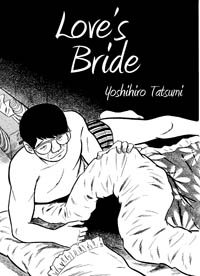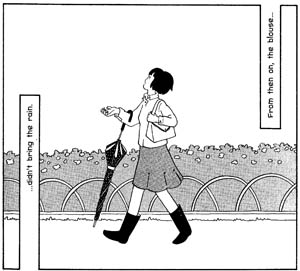 Edited by Sean Michael Wilson
Edited by Sean Michael Wilson
400 pages, black and white
Published by Top Shelf Productions
I’ve been looking forward to Top Shelf’s Ax: Alternative Manga anthology ever since they first announced it. Between reading Secret Comics Japan back in the day (which really needs to come back into print) and the more recent "gekiga" (essentially alternative manga) releases from Drawn & Quarterly (with books like The Push Man and Abandon the Old in Tokyo), it’s been fun seeing some of the different genres and styles of manga being produced in Japan. Ax in Japan was the successor to Garo, the gekiga anthology whose founding is detailed in A Drifting Life. So the idea of a cherry-picked collection of comics from Ax over the past decade? Yes, please.
 Like most anthologies, Ax: Alternative Manga Vol. 1 is a mixed bag in terms of both quality and genre. Some stories are slice of life, while others dip into the more fantastical realms. If I had to pick a single story that would typify what I was expecting from Ax: Alternative Manga, it would probably be Yoshihiro Tatsumi’s "Love’s Bride," about a man whose relationship is going downhill, while simultaneously learning about the courting rituals among monkeys. Like so many of Tatsumi’s stories, it’s a piece with offbeat and slightly deviant characters, and Tatsumi isn’t afraid to depict moments like his protagonist (seen from behind) masturbating to a photo of his girlfriend. "Love’s Bride" doesn’t offer easy solutions to the problems posed, and everyone is slightly flawed in their own way. It’s a fascinating little snapshot, and one that ends in a place that lets the reader draw their own conclusions as to what exactly will happen next.
Like most anthologies, Ax: Alternative Manga Vol. 1 is a mixed bag in terms of both quality and genre. Some stories are slice of life, while others dip into the more fantastical realms. If I had to pick a single story that would typify what I was expecting from Ax: Alternative Manga, it would probably be Yoshihiro Tatsumi’s "Love’s Bride," about a man whose relationship is going downhill, while simultaneously learning about the courting rituals among monkeys. Like so many of Tatsumi’s stories, it’s a piece with offbeat and slightly deviant characters, and Tatsumi isn’t afraid to depict moments like his protagonist (seen from behind) masturbating to a photo of his girlfriend. "Love’s Bride" doesn’t offer easy solutions to the problems posed, and everyone is slightly flawed in their own way. It’s a fascinating little snapshot, and one that ends in a place that lets the reader draw their own conclusions as to what exactly will happen next.
That said, once I started reading Ax: Alternative Manga, I found a much wider array of stories and tones than I had expected. For instance, Shinya Komatsu’s "Mushroom Garden" could just have easily seen print in the Flight anthologies as in Ax: Alternative Manga. Komatsu’s story of a young man who starts growing mushrooms that slowly take over his fantasy city is almost dreamlike in its sense of wonder and imagination; it’s short and sweet, and while it’s certainly a bit odd in places it’s that sort of wide-reaching net that makes Ax: Alternative Manga ultimately so interesting, because you’re not entirely sure just what you’re going to get next. Akino Kondo’s two linked stories ("The Rainy Day Blouse" and "The First Umbrella") for instance, is almost more of a mood piece than anything else, as a young woman deals with the mundane task of buying an umbrella, and how it briefly links to a childhood memory. It’s beautifully drawn, with sparse lines but beautiful postures that remind me of children’s books. For instance, when the protagonist is walking outside with her new umbrella, looking up at the (rainless) sky, there’s something about her chipper pose and tiny half-smile that immediately brings to mind those classic illustrations I saw as a child.
 Some of the stories bring a fantastical element into our real world that immediately grabbed my attention. Ayuko Akiyama’s "Inside the Gourd" is a delicately illustrated story about a young man who looks into a gourd that is supposed to house a caterpillar but instead shows visions of a young woman growing up in a beautiful garden. Akiyama’s story reminds me of the magical realism literary style, never fully defining how this story has happened but instead simply going with the flow and letting its story blossom over time until it gets to a conclusion that offers a promise to the reader of what surely will happen next. It’s one of the early stories in Ax: Alternative Manga Vol. 1, and it’s at that exact moment that I felt the book was going to offer much more than I had initially expected.
Some of the stories bring a fantastical element into our real world that immediately grabbed my attention. Ayuko Akiyama’s "Inside the Gourd" is a delicately illustrated story about a young man who looks into a gourd that is supposed to house a caterpillar but instead shows visions of a young woman growing up in a beautiful garden. Akiyama’s story reminds me of the magical realism literary style, never fully defining how this story has happened but instead simply going with the flow and letting its story blossom over time until it gets to a conclusion that offers a promise to the reader of what surely will happen next. It’s one of the early stories in Ax: Alternative Manga Vol. 1, and it’s at that exact moment that I felt the book was going to offer much more than I had initially expected.
There’s a slightly sillier, humorous aspect to some of the other stories that bring the fantasy into our reality. Both Yusaka Hanakuma’s "Puppy Love" and Namie Fujieda’s "The Brilliant Ones" are crudely drawn, going-for-the-joke stories. From a woman that gives birth to puppies instead of human babies, to a student that explodes into a mass of maggots, they deliberately subvert the reader’s expectations and go for the strange. Neither is the sort of story that you’ll remember later because of their art, but the strange combination of laughs and grim moments (especially in "Puppy Love") will make them stick with you.
 Only a small handful of stories ultimately didn’t work for me. Pieces like Yuka Goto’s "The Neighbor" or Kotobuki Shiriagari’s "The Twin Adults" felt both crude in art and also storytelling, but without providing a punch like Hanakuma or Fujieda that made it memorable. And while stories like Shigehiro Okada’s "Me" at least have some slightly strong art, there’s a certain lack of coherence that just doesn’t make everything connect. Still, for every slight misstep like Mimiyo Tomozawa’s "300 Years" (which seems designed solely to shock rather than to make a point), there are disturbing but interesting pieces like Katsuo Kawai’s "Push Pin Woman" or Hiroji Tani’s "Alraune Fatale."
Only a small handful of stories ultimately didn’t work for me. Pieces like Yuka Goto’s "The Neighbor" or Kotobuki Shiriagari’s "The Twin Adults" felt both crude in art and also storytelling, but without providing a punch like Hanakuma or Fujieda that made it memorable. And while stories like Shigehiro Okada’s "Me" at least have some slightly strong art, there’s a certain lack of coherence that just doesn’t make everything connect. Still, for every slight misstep like Mimiyo Tomozawa’s "300 Years" (which seems designed solely to shock rather than to make a point), there are disturbing but interesting pieces like Katsuo Kawai’s "Push Pin Woman" or Hiroji Tani’s "Alraune Fatale."
While I doubt there’s a reader out there who will like every single story in Ax: Alternative Manga Vol. 1—I’m not entirely sure even the editors would expect that to happen—there’s such a wide variety of story here that there’s a little something for everyone interested in manga’s own alternative comics scene. I’d love for Ax: Alternative Manga to become a regular tradition at Top Shelf Productions; this new glimpse into the side of Japan’s comics industry that we rarely see has me that much more eager to go on a return trip to Ax: Alternative Manga, and soon.
Purchase Links: Amazon.com | Powell’s Books
